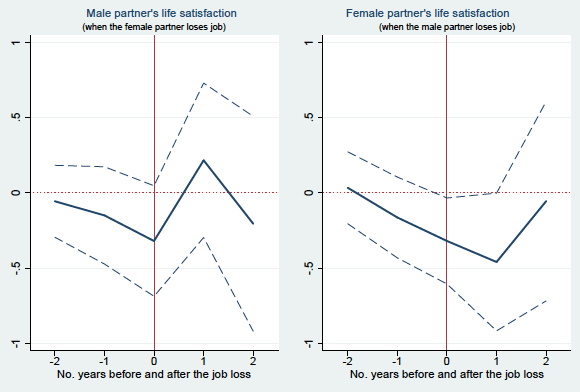How much will your spouse suffer if you become unemployed?
| Date: | 10 July 2018 |
| Author: | Milena Nikolova and Sinem H. Ayhan |

Unemployment can have damaging consequences for individuals and their families. Job loss often means lower income, increased poverty risk, and worse future employment prospects. Evidence from around the world shows that those who are unemployed have worse life satisfaction, happiness, and mental health than the employed. Happiness research reveals that most of these dramatic declines in happiness and life satisfaction are due to psychological factors related to losing identity and social contacts rather than the loss of income.
In a recent paper, we show that unemployment lowers the life satisfaction of spouses living in the same household. We use German household data from 1991 to 2015 that not only trace individuals and their spouses over time but also have information on job loss due to involuntary and unexpected circumstances. These advantages allow us to study the causal effect of a spouse’s unemployment on the other partner’s life satisfaction, as measured on a scale from 0 (not at all satisfied) to 10 (very satisfied).
We find that spousal job loss lowers the life satisfaction of the indirectly-affected partner. Men’s life satisfaction declines by about 0.34 points as a result of their wives’ unemployment, while women’s life satisfaction drops by about 0.25 points after their husbands become jobless. This gender difference is not statistically significant, meaning that husbands and wives suffer just as much when their spouse becomes jobless.
How do these findings compare with the effects of becoming unemployed on one’s own life satisfaction? The spousal life satisfaction losses we document represent about one-third to one-quarter of the average life satisfaction effects for the person who is unemployed, which is quite large. Another way to quantify how much spouses care about their partners’ job loss is to utilize the so-called life satisfaction valuation approach. We simply calculate the amount of household income required to compensate the indirectly-affected spouse for the life satisfaction drop due to the partner’s job loss. We calculate that husbands, whose wives become unemployed, need to be given about 49,300 euros. For women, whose husbands become jobless, the corresponding compensation is about 52,000 euros. These findings remain even if we take into account the directly-affected spouse’s job loss expectations.
Furthermore, our main results do not change if we account for household income, household income from asset flows, as well as future household income. These findings suggest that income does not explain the large declines in spousal life satisfaction following unemployment. At the same time, spousal unemployment dramatically lowers the other spouse’s satisfaction with household income and living standards. At first glance, the finding of declining satisfaction with household income and living standards following unemployment may appear at odds with our result that income does not explain the life satisfaction loss associated with spousal joblessness. Couples experiencing unemployment typically cover their consumption needs with the earnings of the other spouse or from welfare income. Thus, while the cross-spousal psychological costs of unemployment are independent of income, the large income satisfaction declines likely reflect the loss of spousal labor income and the stigma associated with unemployment and living on public welfare.
Finally, we provide novel evidence on whether or not spousal life satisfaction returns to its baseline levels following the other partner’s unemployment. Put another way, do people eventually get used to their partners being unemployed? Figure 1 shows the patterns in spousal life satisfaction before and after the other partner becomes unemployed. Indirectly-affected wives’ life satisfaction does not bounce back to the baseline two years after their husbands’ unemployment, suggesting that there is no adaptation to unemployment for wives (right panel). The picture is less clear-cut for husbands whose wives lose their jobs due to plant closures (left panel).

Our analysis has several policy implications. First, unemployment programs should also consider the fact that the negative consequences of unemployment spill over to other household members and especially female partners. Second, we argue that unemployment policies that simply provide monetary assistance are unlikely to restore affected families’ well-being. At the same time, programs that seek to reduce the psychological burden related to the stigma of being unemployed or receiving unemployment benefits could be a double-edged sword if they prolong the unemployment duration. Finally, employers can use these findings when considering how to design severance packages that take into account households. They should be aware that layoffs scar not only workers but also their families and that the negative psychological effects could be long lasting.
This post is based on research in an article in the Journal of Population Economics. It first appeared on the Brookings Institution’s Future Development blog.

